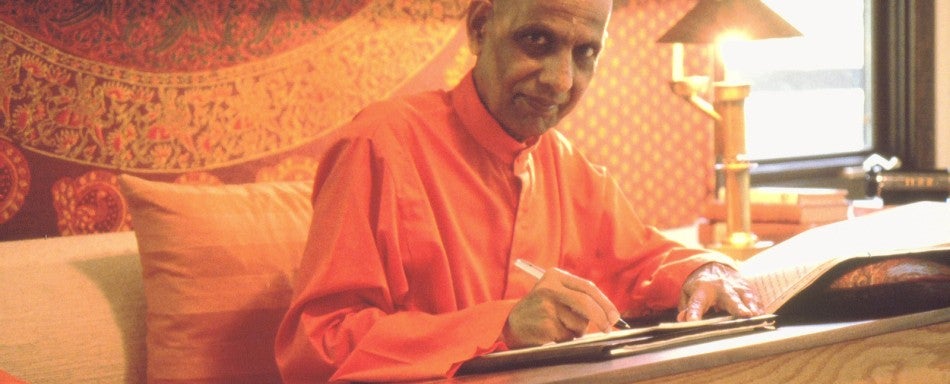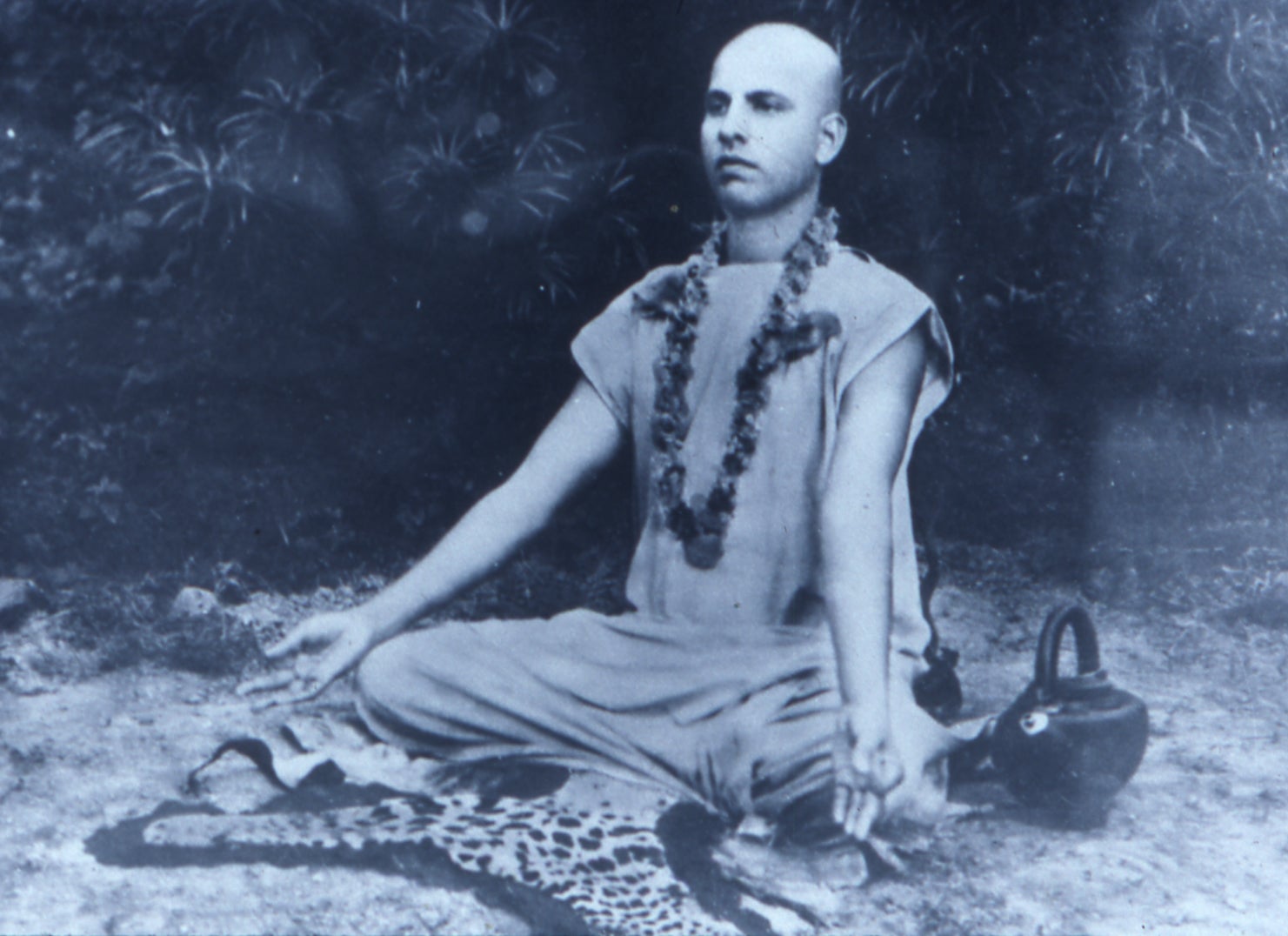
Our History
From the core teachings of Swami Kripalu to the integration of ancient wisdom with contemporary thought, Kripalu has helped to drive the evolution of yoga in the West, and continues to inform its impact in the 21st century.
Kripalu’s history parallels the evolution of yoga in America, which progresses from an exclusive reliance on Eastern tradition, teachers, and cultural forms, to the development of Western teachers steeped in the tradition and able to transmit its authentic depths in formats appropriate to our time and place, to the integration of yoga with contemporary discoveries in medicine, psychology, and science.
The Journey of Swami Kripalu
Saraswati Chandra, later known as Swami Kripalu (pictured above), was born in 1913 in Gujarat, India. At age 17, he began his studies of yoga, Ayurveda, physiology, psychology, and ancient texts, including Patanjali’s Yoga Sutras. In 1942, he was initiated as a renunciate and swami, and given the name Swami Kripalvananda, meaning “compassionate one.”
Over the next decades, Swami Kripalu, as he was known to his students, became a writer, teacher, and inspirational speaker, revitalizing the ancient teachings of yoga by making them applicable to contemporary practitioners. Twenty years after embarking on his study of yoga, Swami Kripalu began to devote himself to intensive practice, spending hours each day doing asana, meditation, and pranayama.
Learn more about Swami Kripalu's life, practice, and history here.

Kripalu Yoga Arrives in the West
One of Swami Kripalu’s closest disciples, Indian-born Amrit Desai, came to the United States in 1960 to attend the Philadelphia College of Art. He began teaching yoga classes that were attended by a growing number of yoga enthusiasts in the Philadelphia area. In 1966, Desai and nine others formed the nonprofit Yoga Society of Pennsylvania to advance the science and philosophy of yoga in the West.
In 1972, Desai; his wife, Urmila; and a handful of dedicated students established a small residential yoga center in Sumneytown, Pennsylvania. The first Kripalu Yoga Teacher Training was offered in Sumneytown in 1973. A year later, the name of the nonprofit organization was changed from the Yoga Society of Pennsylvania to the Kripalu Yoga Fellowship, to reflect an emphasis on the teachings of Swami Kripalu.
In 1975, Kripalu purchased a second, significantly larger facility in Summit Station, Pennsylvania, and established a residential center offering yoga instruction; a curriculum of yoga, holistic health, and self-discovery programs; meals made on-site; and a holistic health center that provided massage and a variety of other health services—the genesis of Kripalu Healing Arts, which remain an important aspect of our offerings and mission.
In 1977, Swami Kripalu came to the United States and spent the last four years of his life in residence at Sumneytown and Summit Station, delivering periodic talks and teachings. He returned to India in 1981, and died shortly thereafter. His teachings on love, practice, and self-development continue to form the basis of the Kripalu approach.
Kripalu Finds Its Permanent Home in Stockbridge
In early 1983, Kripalu purchased its current 125-acre property in Stockbridge, Massachusetts, which was known as Shadowbrook. The land was once lived on by the Stockbridge-Munsee Band of Mohicans, and the main building (called Shadowbrook) is a former Jesuit monastery built on what was the site of a Gilded Age cottage owned by Andrew Carnegie. The doors of Kripalu Center for Yoga & Health were opened in December 1983. In the new location, the residential staff—which numbered more than 350 by the mid-1980s—offered immersion experiences to guests and students who chose from a selection of leading-edge programs and trainings in yoga, health, massage and bodywork, personal growth, and spirituality.
During the late 1980s, Kripalu faculty began to integrate the teachings of yoga with positive psychology, science, and other Western approaches to healing and self-development. Rather than relying exclusively on ancient texts and Sanskrit terminology, the teachings of Kripalu Yoga were increasingly voiced by Western teachers in language that meshed with the contemporary world.
As the number of Kripalu-trained teachers grew, the Kripalu Yoga Teachers Association—now called the Kripalu Yoga and Ayurveda Association (KYAA)—was formed in 1991 to offer continuing support and professional development to alumni. The 2,200 members of KYAA and the thousands of students and clients they reach remain a vital part of the Kripalu community and mission.
The Transition from Ashram to Retreat Center
In 1994, revelations surfaced of sexual and financial improprieties committed by Desai, and the community called for his immediate resignation. In the wake of his departure, the integrity of the original teachings carried Kripalu through the transition from guru-centered ashram to secular retreat center. In 1999, Kripalu shifted from a religious society to an educational organization governed by a Board of Trustees.
In response to the growing national interest in yoga, meditation, and holistic health, Kripalu began to offer an increasing number of yoga teacher trainings, as well as additional programs with visiting presenters—renowned teachers from various yoga traditions, writers, artists, relationship experts, and other thought leaders from around the world. This nonsectarian embrace of all schools of yoga, along with other traditional and contemporary approaches to personal transformation, is an important part of the Kripalu approach.
Over the next decade, Kripalu enjoyed a period of sustained growth, cultivating a program curriculum featuring a rich mix of national and international teachers, while evolving the foundational Kripalu Yoga trainings and programs. Program attendance increased markedly, enabling the organization to expand and prosper.
A Time of Growth and Thriving
Throughout the early 2000s, Kripalu continued to expand and evolve its trainings and outreach. In 2001, the Teaching for Diversity fund was created to support yoga teachers sharing the practice with populations around the country and the world who might not have access to it otherwise. The Kripalu Schools expanded to encompass the School of Yoga; the School of Ayurveda, founded in 2005; the School of Integrative Yoga Therapy, founded in 2016; and the School of Mindful Outdoor Leadership, founded in 2018. In June 2009, a new, 80-room, environmentally sensitive residential building, the Annex, was completed to augment the 171 guest rooms in the Shadowbrook building.
In 2010, the Kripalu Institute for Extraordinary Living (IEL) was formed, and in collaboration with researchers at Brigham and Women’s Hospital, launched groundbreaking research—which continues today—on the impact of yoga on physical and mental health. In 2017, the IEL evolved into RISE™, a Kripalu social-impact program that brings stress-resilience trainings to people in law enforcement, education, the healthcare and human services industries, and corporate workplaces.
Through scholarships, Kripalu provides $250,000 annually for frontline providers to attend RISE programming on- and off-site; and for individuals to attend programs and train in the Kripalu Schools as yoga teachers, yoga therapists, Ayurvedic practitioners, and Mindful Outdoor Guides.

You Might Also Be Interested In
Explore equity work at Kripalu throughout the years.
Explore the history of our main building on the Kripalu campus.
Despite tremendous hardship in being forced from here, today their community resides in Wisconsin and is known as the Stockbridge-Munsee Community.